|
Fifth Dimension Site Map Search Contact Us |
|||

|
Self-Care and Activities of Daily Living |
||
|
|||
Self-Care and Activities of Daily Living
Back to the Table of Contents
Attention to self-care and daily living skills, such as brushing your teeth, shaving, combing your hair, getting dressed, etc., serves three purposes: it increases your ability to perform these activities, provides overall muscle toning and increases your range of motion.
Performing as many self-care tasks as possible will also help you develop independence and self-esteem. Feeling dependent on others can be defeating, and a certain satisfaction can be gained from setting objectives in life and accomplishing them. Recovering from an illness or injury is certainly one of these accomplishments.
Consider the degree of physical effort required for self-care tasks in terms of graduated levels based on how much mobility and energy each activity requires. Feeding yourself requires the least amount of effort. When you are stronger, you will be able to graduate to the activities of hygiene and grooming; still later, you'll be able to bathe and dress yourself. Your overall goal is to return to your former activities as fully as possible. Keep a Self-Care Progress Chart like the one at the end of this chapter. Make a list of all the activities you perform daily in caring for yourself, and then add each new accomplishment to the list along with the date on which you achieve it.
Many assistive devices or gadgets are available to help you retrain yourself, making certain tasks easier to accomplish. You must conserve energy, using it appropriately to achieve both short-term and long-term goals. In addition, you should consider safety in the home. When you are tired and weak, it is all too easy to have an accident that could slow your recovery or even reverse your physical status dramatically.
Assistive Devices
Back to the Table of Contents
An assistive device compensates for loss of function and enhances your ability to take care of yourself more comfortably and safely. Such devices can be as simple as a long-handled bath brush or as complex as a wheelchair. Assistive devices can be obtained from medical and surgical supply stores, listed in your yellow pages telephone directory, or by mail order from self-help companies. Your local hospital will also have the names of supply companies in your area. Some commonly used devices are described below; many can be improvised at home.
Occupational Aids
Back to the Table of Contents
-
- One-handed bread and vegetable board
- One-handed vegetable basket for straining cooked vegetables
- One-handed bread and vegetable board
- One-handed electric can opener
- One-handed Spill Not bottle and jar holder
- Spill Not and rubber twister for unscrewing lids of bottles and jars
- Multipurpose clamp that provides good leverage for small items, for turning knobs (e.g., on a TV or radio)
- Electric plugs with handle
- One-handed suction nail brush
- One-handed suction nail file
Eating and Drinking Aids
Back to the Table of Contents
| Special cups with lids will help you avoid spilling liquids.
If you have poor coordination or trouble swallowing, the Tommee Tippee cup is useful. |

|
| The Wonder-Flow vacuum cup allows you to drink while lying flat on your back or on your side. These cups can be used with straws. Use extra-long (18 in./46 cm) straws if you tire while trying to hold a cup. You can also improvise with foam cups that have plastic lids, such as those used in take-out food places.
Serve soup in a cup for ease and safety. |
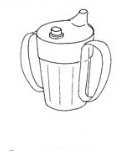 |
| If you have trouble swallowing, a plastic glass with a cutout for the nose will allow you to drink without tipping your head back, as a precaution against choking. The Tommee Tippee cup is also helpful. |  |
| If your grasp is weak, a stretch-knit coaster clipped around a glass will give you a firmer grip. You can also use adhesive-backed bathtub safety treads or similar rubber decals wrapped in a spiral around the glass. |  |
| The Mac Mug has an easy-to-grasp T-shaped handle that is insulated to protect heat-sensitive skin. Two-handled cups, such as children's cups or the Tommee Tippee cup, are also helpful. |  |
| Built-up handles on knives, forks and spoons will help if you have difficulty in grasping. You can improvise these by using foam-rubber hair curlers, sponge rubber or washcloths. |
 |
| If you have difficulty with coordination, a plate guard will prevent food from being pushed off the plate. The guard clips onto the edge of the plate and acts as a stable surface to push against. You can also use a dish with a high edge, such as a pie plate, or a special plate that is raised on one side. | 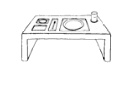
|
| If you must have your meals in bed, a firm wedge-shaped cushion behind your back will place your body in a more comfortable position, especially for swallowing. | 
|
| Use a breakfast tray with legs or a serving tray, or improvise with a cardboard box with spaces cut out on the long sides for your legs. Cover the tray's surface with a damp towel or some other material to keep dishes from sliding. |
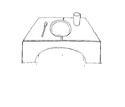 |
Bathing Aids
Back to the Table of Contents
| Grab bars can be fastened to the bathtub or attached to the wall for safety and ease in getting in and out of the tub or shower. | A combination grab bar and bath seat is available in many styles to fit all needs and types of bathroom fixtures. | A bath seat will help you get in and out of the bathtub and allow you to sit in the shower. | A portable showerhead can be used with a bath seat to shower in the bathtub. |
 |
 |
 |
 |
Toilet Aids
Back to the Table of Contents
A raised toilet seat makes coming to a standing position more comfortable (especially if you are bothered by hip pain). Easy-to-clean padded-vinyl toilet seats are also available.
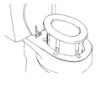 |
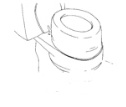 |
 |
Energy Conservation
Back to the Table of Contents
Conserving energy in small tasks will help you to have the stamina necessary to do daily self-help and other, more pleasurable activities. By eliminating unnecessary steps or movements, you will build up an energy reserve that lets you enjoy a more productive and fulfilling day. Analyze your day, and pace yourself so that work is in accordance with your energy level. Do heavier tasks when your energy is high, and save lighter tasks for rest times.
Dressing
Back to the Table of Contents
| Try to do the major part of this task while seated in a chair, preferably one with arms.
Long-handled reachers will eliminate your having to bend over and will help you get garments started over your feet. It is easier to put your weak arm or leg in first when dressing and to take your strong arm or leg out first when undressing. |
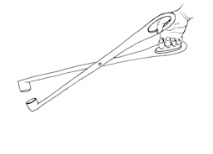
|
| Loose-fitting tops with front-closing zippers, ties or buttons are most convenient.
A buttonhook may help you with manipulating small shirt and trouser fastenings. If you are not ready to dress in street clothes, an attractive lounging outfit or muumuu will give you and those around you a boost in morale. |
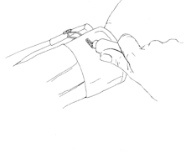
|
Housework
Back to the Table of Contents
-
- Where possible, sit rather than stand. Bar stool height is a compromise between standing and sitting.
- Have work in front of you rather than at the side.
- Reduce effort when moving by moving slower and not lifting as much as before.
- Slide rather than lift objects.
- Try to maintain good posture when standing, bending or sitting.
- To reduce fatigue, use fitted bedsheets to eliminate energy spent on bed making.
- To decrease the need for bending, use long-handled dustpans and self-wringing mops.
- Store frequently used items close to you.
- Containerize: put everything needed for a task in a basket or box--an example would be grouping together items for morning care.
- Wear a cobbler's apron or similar garment for carrying small lightweight items to reduce unnecessary trips about the house.
- Use a wheeled cart for moving items from one room to another.
- Alternate work and rest periods.
- Plan a basic itinerary each day in order to reduce unnecessary motions and steps.
- Pace your work schedule. Don't try to complete all tasks in one day. Have a weekly plan for scheduling major tasks such as washing, ironing, shopping and cleaning, so that one task can be done each day.
Cooking
Back to the Table of Contents
-
- Plan ahead with meal preparation. Write menus for a week's meals at a time.
- Shop for staples once a week and for fresh produce twice weekly.
- Assemble all ingredients and utensils before beginning to prepare a dish.
- Make larger quantities, and freeze portions for later use.
- Plan how to use leftovers when cooking.
- Don't be reluctant to use frozen or convenience foods. You can add your own seasonings.
- A Crock-Pot slow cooker will allow you to cook a one-pot meal with minimum preparation time and effort. Your dinner will cook safely in it throughout the day, allowing you to rest.
- Use small tabletop appliances to eliminate unnecessary standing or bending.
- Use lightweight cookware to conserve energy.
- Use nonstick cookware for ease in cleaning up.
- Use paper plates or plastic cups for snacks or lunches to eliminate dishwashing.
Safety
Back to the Table of Contents
-
- Remove scatter rugs.
- Clear floors of all small objects, such as bathroom scales or doorstops, to reduce the risk of slipping or tripping.
- Install additional phones to avoid tripping over extension cords.
- Avoid loose or floppy slippers or shoes.
- Check all stair treads and thresholds for loose hardware.
- Since most falls occur on the bottom step of stairs, make that step highly visible by painting it a different color or having it well lit.
- Whenever railings are present, hold onto them. Railings can also be easily installed when there are none.
- Have a lamp beside your bed so you don't stumble in the dark.
- To prevent dizziness when you first get out of bed, sit and dangle your feet for a moment before standing up.
- Use an electric heating pads with caution: you may misjudge the heat.
- Check the bathroom. Put adhesive-backed rubber strips in the tub or shower to prevent slipping. Buy soap on a cord and hang it around the faucet or your neck.
- When in the kitchen, do not reach across a hot burner.
- Survey your own living situation and take precautions that would benefit you.
- Have a large, easy-to-read list of emergency numbers, including fire, police, relatives and friends, near your telephone
|
You are welcome to share this © article with friends, but do not forget to include the author name and web address. Permission needed to use articles on commercial and non commercial websites. Thank you. |